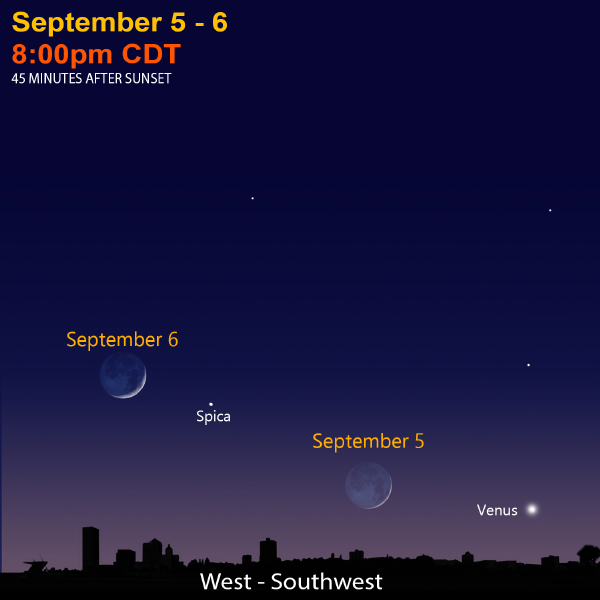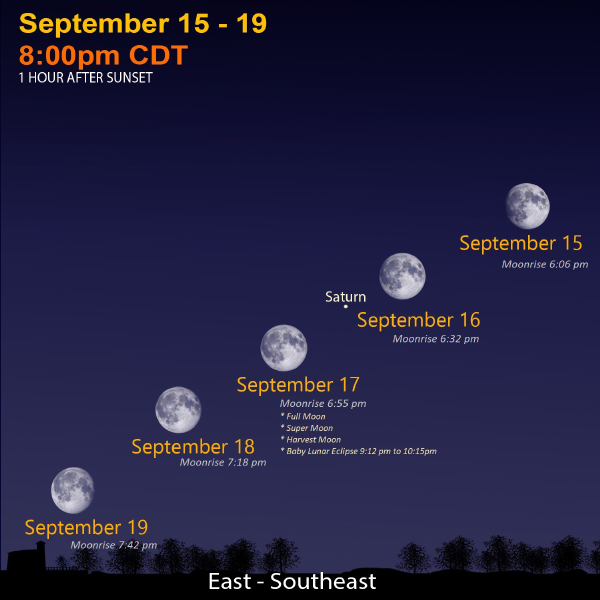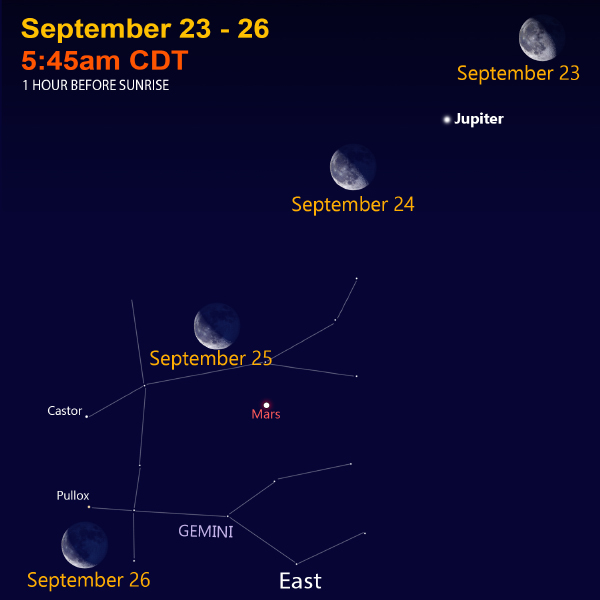Cosmic Curiosities
“There wouldn’t be a sky full of stars if we were all meant to wish on the same one.”
- Frances Clark, American Pianist and Academic
Marvelous Moonlight
On the full moon night of September 17, there will be an eclipse, a supermoon, and a Harvest Moon!
Baby Lunar Eclipse
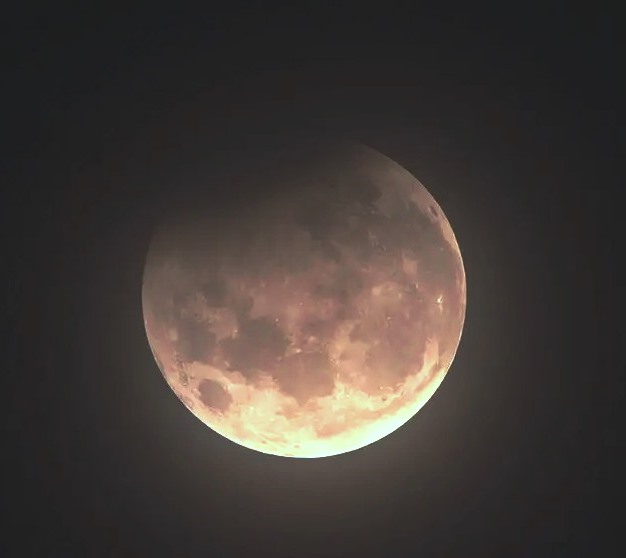
On Tuesday night, September 17, there will be a baby lunar eclipse. Our moon will barely pass through the Earth’s dark umbral shadow. We will view the eclipse through a telescope here at MPM; stop by if skies are clear!
Partial Lunar Eclipse Watch (clear skies permitting)
WHERE: Outside MPM by Green Clock on Wells Street (no entrance to MPM)
WHAT: See eclipse through a telescope
WHEN: Tuesday, September 17, 8:45-10:15 p.m. CDT (eclipse starts at 9:12 p.m. and ends at 10:15 p.m.)
Supermoon
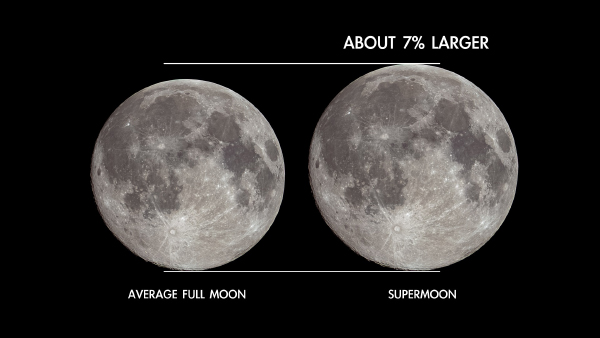
Supermoons are not that super. On September 17, the moon will appear to be a little bigger (7%) than an average full moon. Still, these slightly bigger full moons are barely noticeable to the human eye. Of course, a 7% pay raise at work would be a rather recognizable!
Though they have a small bump in size, supermoons are a bit brighter because the moon is closer in its elliptical orbit. Some say this increased brightness can be seen. Personally, I have never detected this effect.
Supermoons do have one measurable effect: the tides. With a closer moon exerting a little more gravity on Earth, higher water levels occur when the tides roll in.
Harvest Moon
The Harvest Moon is the full moon (September 17) nearest the first day of fall (September 22).
During this time of year, the moon rises less than 30 minutes later each night. Since the two moons before and after the full moon look nearly full, it can seem as though there are five full moons in a row! Back in the day, all these “full moons” provided extra moonlight for farmers to bring in their harvest.
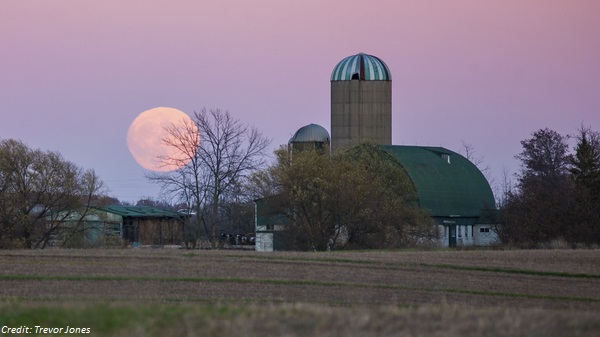 Here are the moonrise times this year for the five Harvest Moons:
Here are the moonrise times this year for the five Harvest Moons:
| Date | Sunset | Moonrise |
|---|---|---|
| September 15 | 7 p.m. | 6:06 p.m. |
| September 16 | 6:58 p.m. | 6:32 p.m. |
| September 17* | 6:56 p.m. | 6:55 p.m. |
| September 18 | 6:55 p.m. | 7:18 p.m. |
| September 19 | 6:53 p.m. | 7:42 p.m. |
*Harvest Moon
New Star Soon?
Stargazers may see a “new” star very soon. Some astronomers predict this celestial treat will happen this September, in the constellation Corona Borealis—the northern crown.
The new star will not actually be new. It’s a periodic explosion of a white dwarf star called T Coronae Borealis, or T CrB. This fiery event is called a nova, or a recurrent nova.
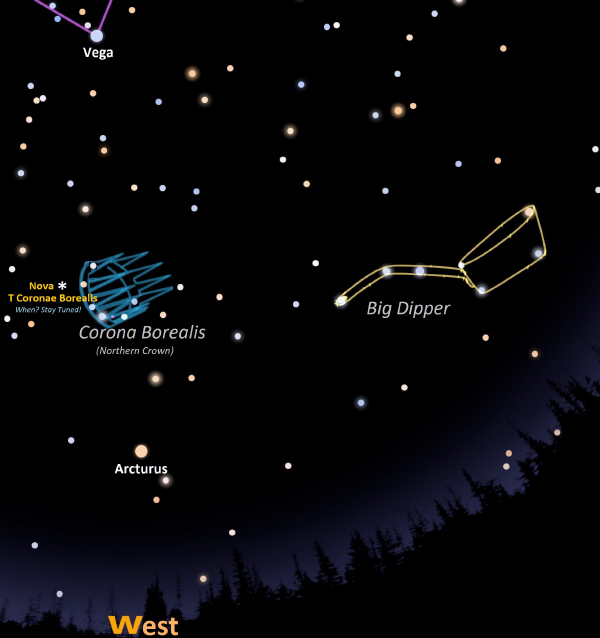
Location of “New Star”
A white dwarf is basically a dead star. They have stopped shining by nuclear fusion of hydrogen and helium. All that is left is an incredibly compact core made mostly of carbon and oxygen. One teaspoon of a white dwarf star would weigh as much as an elephant, or 5.5 tons.
The gravity from these corpse stars can steal gas from a nearby star when they get too close. T Coronae Borealis has one of these—a red giant star with lots of hydrogen gas to pilfer. When T Coronae Borealis takes enough gas, it causes a thermonuclear explosion that blasts away the gas it just stole. Like a zombie, the star has come back to life.
Nova Sequence
T Coronae Borealis last did this in 1946. The first recorded sighting of the T CrB nova was more than 800 years ago in Germany.
HOW BRIGHT?
Some call T Coronae Borealis the “Blaze Star.” When it detonates soon, it will shine 1,000 times brighter to become a 2nd magnitude star. This brightness is comparable to the North Star, which can be seen in the city but isn't really that bright.
The increased brightness will only last a few nights. The blast will quickly dissipate. Then, the star will go back to stealing gas from its red giant neighbor. By the early 22nd century, about 80 years from now, T Coronae Borealis will have stolen enough gas once again; it will explode. Future stargazers will see this nova and marvel at the life cycles of the stars.
NOVA VS. SUPERNOVA
When T Coronae Borealis goes boom, it will be a nova, not a supernova. This white dwarf star ignites but doesn’t completely explode. It lives to do it again. When the star accumulates a critical mass—1.4 times the mass of our sun—it will go supernova, or totally explode. Astronomers predict this will eventually happen to T Coronae Borealis far off in the future. This starburst will be much brighter and more dazzling to everyone watching the night sky.
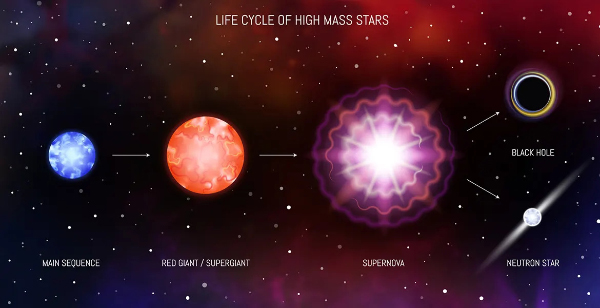
Type 2 Supernova Sequence
A type 2 supernova is when a massive star—much bigger than the sun—runs out of nuclear fuel. As its hydrogen runs out, it fuses helium and swells to become a red giant star. When the helium is exhausted, it fuses carbon and oxygen into heavier elements in its core. After it fuses these heavy elements into iron, the star is done shining. A star can’t fuse iron into any element that is heavier to keep it going. Suddenly, the star collapses upon itself…
Immense amounts of falling gas descend toward the iron core. When the core is hit, the material rebounds violently. It jettisons wildly away in all directions as a supernova. Yet, the extremely compressed core survives this onslaught. The core’s powerful gravity squeezes itself tighter and tighter. It eventually becomes a neutron star, or a black hole.
The last type 2 supernova in the Milky Way galaxy that was easily seen in Earth’s skies was 1604! On average, type 2 supernovae happen once every 50 years in our Milky Way galaxy. Type Ia supernovae are rarer, exploding about once every 500 years in the Milky Way.
Space in Sixty Seconds
Check out a baby eclipse and the return of Venus!
Sky Sights
A waxing crescent Moon can be seen near Venus just after sunset on September 5 and 6. They set soon after the sun, so make sure you have a clear line of sight to the horizon.
From September 15 to 19, watch the Moon pass Saturn after sunset. Don’t forget the baby lunar eclipse on September 17.
The Moon rolls by Jupiter and Mars from September 23 to 26. Look high in the sky in Gemini about one hour before sunrise. These two planets will soon move to the evening sky. By month’s end, Jupiter rises at 10 p.m. and Mars at 11:40 p.m.
Mercury can be caught by early birds early in the month. Look low in the ENE sky about 45 minutes before sunrise. By September 15, the smallest planet will be too difficult to see.
September Star Map
Sign Up
Receive this newsletter via email!
Subscribe
See the Universe through a telescope
Join one of the Milwaukee-area astronomy clubs and spot craters on the Moon, the rings of Saturn, the moons of Jupiter, and much more.
Follow Bob on social media
Twitter: @MPMPlanetarium
Facebook: Daniel M. Soref Planetarium


